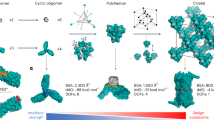Abstract
The paper describes the formalization and implementation of an efficient constraint programming framework operating on 3D crystal lattices. The framework is motivated and applied to address the problem of solving the ab-initio protein structure prediction problem—i.e., predicting the 3D structure of a protein from its amino acid sequence. Experimental results demonstrate that our novel approach offers up to a 3 orders of magnitude of speedup compared to other constraint-based solutions proposed for the problem at hand.
Preview
Unable to display preview. Download preview PDF.
Similar content being viewed by others
References
Agarwala, R., et al.: Local rules for protein folding on a triangular lattice and generalized hydrophobicity in the HP model. J. Computational Biology, 275–296 (1997)
Apt, K.R.: Principles of constraint programming. Cambridge University press, Cambridge (2003)
Backofen, R.: The protein structure prediction problem: A constraint optimization approach using a new lower bound. Constraints 6(2–3), 223–255 (2001)
Backofen, R., Will, S.: A Constraint-Based Approach to Structure Prediction for Simplified Protein Models that Outperforms Other Existing Methods. In: Palamidessi, C. (ed.) ICLP 2003. LNCS, vol. 2916, pp. 49–71. Springer, Heidelberg (2003)
Berman, H.M., et al.: The Protein Data Bank. Nucleic Acids Research 28, 235–242 (2000)
Berrera, M., Molinari, H., Fogolari, F.: Amino acid empirical contact energy definitions for fold recognition in the space of contact maps. BMC Bioinformatics 4(8) (2003)
Center for Computational Materials Science, Naval Research Labs, Crystal Lattice Structures, http://cst-www.nrl.navy.mil/lattice/
Clark, D., et al.: Protein topology prediction through constraint-based search and the evaluation of topological folding rules. Protein Engineering 4, 752–760 (1991)
Clote, P., Backofen, R.: Computational Molecular Biology. John Wiley & Sons, Chichester (2001)
Crescenzi, P., et al.: On the complexity of protein folding. In: STOC, pp. 597–603 (1998)
Dal Palù, A., Dovier, A., Fogolari, F.: Constraint logic programming approach to protein structure prediction. BMC Bioinformatics 5(186) (2004)
Dal Palù, A., Dovier, A., Pontelli, E.: Heuristics, Optimizations, and Parallelism for Protein Structure Prediction in CLP(FD). In: Proc. of PPDP 2005 (2005)
Forman, S.: Torsion Angle Selection and Emergent Non-local Secondary Structure in Protein Structure Prediction. PhD thesis, U. of Iowa (2001)
Greenberg, H.J., et al.: Opportunities for Combinatorial Optimization in Computational Biology. INFORMS Journal of Computing (2003)
Hart, W., Newman, A.: The computational complexity of protein structure prediction in simple lattice models. CRC Press, Boca Raton (2003) (to appear)
Krippahl, L., Barahona, P.: Applying Constraint Programming to Protein Structure Determination. In: Jaffar, J. (ed.) CP 1999. LNCS, vol. 1713, pp. 289–302. Springer, Heidelberg (1999)
Raghunathan, G., Jernigan, R.L.: Ideal architecture of residue packing and its observation in protein structures. Protein Science 6, 2072–2083 (1997)
Rodosek, R.: A Constraint-based Approach for Deriving 3-D Structures of Cyclic Polypeptides. Constraints 6(2-3), 257–270 (2001)
Rost, B.: Protein Secondary Structure Prediction Continues to Rise. J. Struct. Biol. 134 (2001)
Skolnick, J., et al.: Reduced models of proteins and applications. Polymer 45, 511–524 (2004)
Toma, L., Toma, S.: Folding simulation of protein models on the structure-based cubo-octahedral lattice with contact interactions algorithm. Protein Science 8, 196–202 (1999)
Author information
Authors and Affiliations
Editor information
Editors and Affiliations
Rights and permissions
Copyright information
© 2005 Springer-Verlag Berlin Heidelberg
About this paper
Cite this paper
Dal Palù, A., Dovier, A., Pontelli, E. (2005). A New Constraint Solver for 3D Lattices and Its Application to the Protein Folding Problem. In: Sutcliffe, G., Voronkov, A. (eds) Logic for Programming, Artificial Intelligence, and Reasoning. LPAR 2005. Lecture Notes in Computer Science(), vol 3835. Springer, Berlin, Heidelberg. https://doi.org/10.1007/11591191_5
Download citation
DOI: https://doi.org/10.1007/11591191_5
Publisher Name: Springer, Berlin, Heidelberg
Print ISBN: 978-3-540-30553-8
Online ISBN: 978-3-540-31650-3
eBook Packages: Computer ScienceComputer Science (R0)




